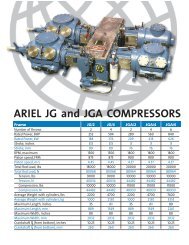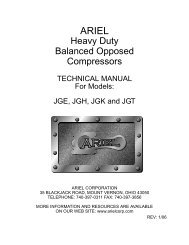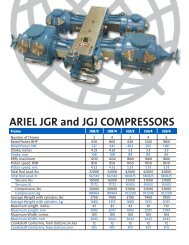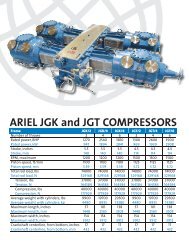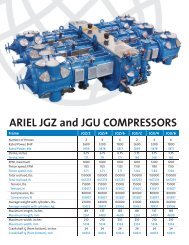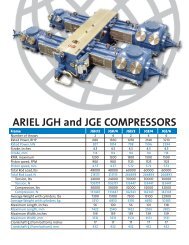Heavy Duty Balanced Opposed Compressors
Heavy Duty Balanced Opposed Compressors
Heavy Duty Balanced Opposed Compressors
Create successful ePaper yourself
Turn your PDF publications into a flip-book with our unique Google optimized e-Paper software.
FOR MODELS: JG AND JGA SECTION 5 - MAINTENANCE<br />
Water-Cooled Compressor Rod Packing<br />
When any disassembly of water-cooled rod packing cases is required, proper re-assembly<br />
and testing is required. This is to ensure that the cases do not leak.<br />
Re-assembly<br />
Cases are lapped, and care must be taken to prevent scratching of the mating surfaces of<br />
the cups. Scratches can cause significant leakage problems.<br />
The cups are numbered on the outside diameter and are to be assembled in consecutive<br />
order, starting with the end cup. The studs are offset so the cups will only fit one way.<br />
Make sure the tie studs are completely screwed into the end cup. Put the proper ring in the<br />
groove and facing the proper direction. Be careful when sliding parts onto the tie studs to<br />
ensure that no scratching occurs to the lapped faces.<br />
Install second cup next, put the rings into place, and make sure the two (2) small O-rings are<br />
in place around the coolant holes.<br />
Continue assembling the remaining parts in the proper configuration to the packing case<br />
drawing. In consecutive order, by repeating the above step.<br />
Install tie stud-nuts and tighten to the values given in Table 1-15 on page 1-15. Using fingers,<br />
make sure that all rings move freely, radially, in their grooves. Side loaded AL rings will<br />
be snug, but should still move using fingers.<br />
Testing<br />
100% verification of function is required for all internal passages.<br />
The passages are to be checked by blowing compressed air thru the connection taps on the<br />
flange and verifying that air is exiting at the proper holes. When air is applied to the connection<br />
tap stamped “Coolant In”, air should be exiting the connection tap stamped “Coolant<br />
Out”, or if air is applied to the tap stamped “Lube”, air should be exiting at the appropriate<br />
cup on the inside diameter of the case.<br />
Pressure leak test packing cases as follows:<br />
1 Plug the “Coolant Out” connection><br />
2 Apply 60 to 100 psi (400 to 700 kPa) dry, compressed air pressure to the “Coolant<br />
In” connection. For water cooled rod packing cases in non-lube service,<br />
compressed air is to be oil free. Air should exit at connection tap “Coolant Out”.<br />
Air applied to the tap stamped “Lube” should exit at the appropriate cup on the<br />
inside diameter of the case.<br />
3 Plug the “Coolant Out” connection and apply 60 to 100 psi (400 to 700 kPa) dry,<br />
compressed air pressure to the “Coolant In” connection through a ball valve with<br />
a calibrated pressure gauge located between the ball valve and packing case.<br />
Close the ball valve and disconnect the air supply. There should be no pressure<br />
drop for 5 minutes minimum.<br />
4 If water cooled packing cases are used in lubricated applications, leak testing<br />
may be done by submersing the packing case in oil with 10 to 100 psig (400 to<br />
700 kPa) test air pressure. After the air trapped in the ring grooves has been<br />
11/01 PAGE 5 - 37





